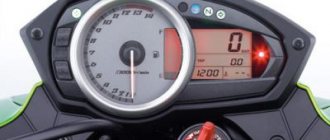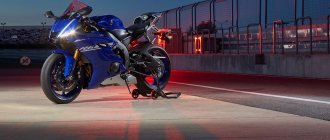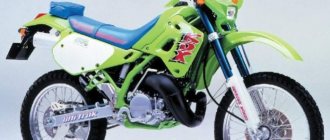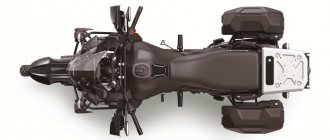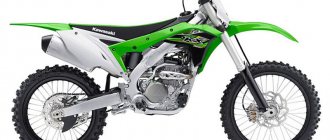| Kawasaki KLX300 (KLX300-D) 2021+ |
Kawasaki KLX 300 soft enduro model
appeared in 2021, replacing the Kawasaki KLX 250 version, for which 2021 was the last year of production.
The new model was built on the basis of the Kawasaki KLX300R sports enduro, differing from it in more civil settings of the engine, suspension and chassis, as well as the presence of lighting equipment that allows the motorcycle to be used on public roads. The factory model designation is KLX300-D
.
The Kawasaki KLX300 model features a standard and well-recognized KLX250 appearance, a steel frame, long-travel adjustable suspension, an injection power system and a 6-speed gearbox.
The model is officially presented only in the North American market, while in Europe and Japan, as of 2021, it is not sold.
In parallel with the enduro version of the Kawasaki KLX300, a motard built on a common base was presented, called the Kawasaki KLX300SM. This modification is also only available in North America.
The main competitors of the Kawasaki KLX300 in the class:
- Honda CRF300L
Engine Kawasaki KLX300
The new Kawasaki KLX300 dual-sport motorcycle is powered by a 292cc single-cylinder DOHC liquid-cooled enduro-based engine. The camshaft profiles are borrowed from the KLX300R off-road model, as are the cylinder technologies, including electromelting of aluminum and ultra-durable wall coating. The result is crisp throttle response, complemented by friendly low- and mid-range performance, and improved engine reliability. The lightweight piston, pin and connecting rod allow for increased effective rpm. However, Kawasaki has not yet released power and torque figures.
The low moving mass of the engine is due to the use of a separate camshaft cam for each valve with washer-based pushrods, which also improves engine efficiency at high speeds. Comfort on long trips is achieved by low engine installation, which lowers the center of mass of the motorcycle. The flat piston and dual-chamber combustion chamber configuration provide a compression ratio of 11.1:1.
The injection power system ensures reliable starting of the Kawasaki KLX300 engine in any conditions, and the electric starter further facilitates this process. Optimized ignition timing and a balance shaft on the gear drive ensure smooth engine operation with comfortable traction characteristics for increased comfort on long journeys.
Kawasaki KLX300
Cooling upgrades include the use of two narrower radiators. The cooling fan shroud directs hot air down and away from the rider, improving comfort in traffic jams or when riding in the heat.
The transmission ratios make the Kawasaki KLX300 easy to use both on and off-road.
The exhaust system of the Kawasaki KLX300 is equipped with a honeycomb catalytic converter, secondary air system and spark arrestor.
Kawasaki: end of year premieres
The absence of the usual global autumn motorcycle exhibitions has already affected our way of life. However, it seems that motorcycle manufacturers are still operating on a run-in program, preparing a “pack” of new motorcycles for the canceled EICMA and Intermot. Kawasaki was no exception, having shown before the beginning of the last month of the year the updated Ninja ZX-10R, a new supermotard, a Z H2 streetfighter with improved suspension, and also demonstrated at the stand a working prototype of a completely new hybrid motorcycle.
Kawasaki KLX300 and KLX300 SM
As you know, a supermotard is an enduro or cross-country motorcycle with “small” wheels shod in road tires. Nowadays, factory-ready supermotos are not uncommon; many manufacturers offer customers motorcycles in this form factor. Kawasaki also released the KLX250SF supermotard in 2009 and 2010.
And now a decade later, the Japanese manufacturer has decided to revive the supermoto sector, preparing for the 2021 season not only the KLX300 enduro, but also the KLX300 SM supermotard.
Both bikes have a tubular steel space frame, 43mm inverted forks and a gas-assist monoshock with Uni-Trak progressive linkage.
The KLX300 and KLX300 SM have a 292 cc short-stroke (78.0 x 61.2 mm) single-barrel engine with a compression ratio of 11.1:1 and a 6-speed gearbox.
The enduro has 18- and 21-inch wheels; the motard has 17-inch wheels, shod with IRC Street Winner road tires. The saddle height of the SM version has also logically decreased, from 895 to 860 mm.
Both motorcycles have the same 240mm rear brake discs with a single-piston caliper, with a 250mm petal or 300mm semi-floating disc brake at the front, depending on the version.
Prices are already known: $5,599 for the Kawasaki KLX300 in Lime Green, $5,799 for the same in Fragment Camo Gray. The KLX300 SM will cost $5,999 and will be available next year in Lime Green/Ebony and Oriental Blue/Ebony color schemes.
Kawasaki Z H2 SE : Skyhook suspension
The Kawasaki H2R supercharged streetfighter was ready for early 2021. By 2021, the Kawasaki Z H2 will receive a new Showa electronic suspension and improved brakes, as well as an SE postfix in the name.
The 2021 Kawasaki Z H2 SE will be equipped with the Kawasaki Electronic Control Suspension (KECS) system, which uses sensors located on the fork and shock absorber, as well as data from the inertial accelerometer, engine control unit and anti-lock braking system. The system analyzes data using Showa Skyhook Electronically Equipped Ride Adjustment (EERA) algorithm and changes the characteristics of the front and rear suspension to suit the riding conditions.
Next year's Z H2 SE will get 320mm front brake discs with Brembo Stylema monobloc radial calipers and a Brembo master cylinder, and a 260mm brake disc at the rear.
You have to pay for every upgrade, and the price of the Kawasaki Z H2 SE, which increased by $2,200 to $19,700, was no exception.
Kawasaki Ninja ZX-10R
The Kawasaki Race Team and their Ninja ZX-10RR have dominated the world superbike scene since 2015. Six titles won and Euro 5 restrictions coming into force - what is not a reason to update Kawasaki superbikes? The premiere of the new Ninja ZX-10R took place during the winter test of the World Superbike Championship in Jerez, Spain.
For the coming year, KRT has improved the Ninja ZX-10R engine, which received an electric valve drive, new gear ratios in the gearbox, an oil cooler, and, of course, a new Euro-5 exhaust system. The 16-valve 998 cc in-line four increased its power to 200 hp. pp., becoming more environmentally friendly, and is also now used as a loaded element of a motorcycle frame. The 2021 ZX-10R features a new forward-biased geometry with a longer swingarm for stability and reduced front wheel offset for aggressive handling.
The '21 superbike has advanced electronics, including launch control, ABS, quickshifter, engine braking control, traction control, cruise control with 3 standard and 4 customizable modes, 4.3-inch TFT display, Bluetooth compatibility and the ability to connect to the Rideology app.
We also worked on the brake system, installing new pads and moving the rear master cylinder reservoir. The Showa Balance Free fork is now installed in lowered yokes; its spring stiffness, compression and rebound settings have been changed, and the weight distribution has been shifted to the front of the motorcycle.
The motorcycle received a new fairing with LED optics. The ABS version weighs 207 kilograms, the ZX-10R without ABS weighs 205. The cost in the US will be $16,399 for a black ZX-10R, for a carbon gray one you will have to pay $16,699, and ABS will increase the cost of the motorcycle by another $1,000.
Kawasaki hybrid motorcycle
On November 23, a Kawasaki promotional video appeared on Youtube, telling about some of the details of the new hybrid motorcycle that Kawasaki engineers are currently working on.
The new product will have both an electric motor and an internal combustion engine, as well as Kawasaki Rideology technology, which allows the bike to “know” where it is and switch on the appropriate operating mode using one or both power plants.
At the end of the video, a motorcycle part consisting of a swingarm, wheel and rear sprocket from a Z900 and a frame from a Ninja 400 or Z400 is shown on the bench. It's not clear which gasoline engine was used, but it could be the slightly more powerful engine from the Z400 or the slightly more fuel-efficient one from the Kawasaki Z250.
Be that as it may, one thing is clear: in the near future we can expect the premiere of a new, super-economical and environmentally friendly Kawasaki hybrid motorcycle.
Chassis and suspension Kawasaki KLX300
The KLX300's perimeter steel frame is constructed from round and rectangular tubular sections to provide a narrow, lightweight configuration. The steering angle is 26.7 degrees, and the short wheelbase gives excellent handling. The lightweight and durable D-section aluminum swingarm ensures low unsprung weight.
The inverted 43mm cartridge fork features compression smoothing adjustment. The Uni-Trak rear suspension provides excellent traction and smoothes out bumps. A gas-filled shock absorber with adjustable spring preload and rebound damping allows you to customize the behavior of the rear suspension to suit different driving conditions. The front suspension travel is 25cm, and the rear suspension travel is 23cm.
Do SUVs dream of electric sheep?
I close my eyes - and in front of them there is a picture with green hills... These memories are etched in my memory and reinforced by strength and endurance exercises, and endorphins from the feeling of freedom and beauty of the world around me. Enduro enthusiasts will know what I'm talking about, and if you're one of us, you'll probably want to check out the experience for yourself. For beginners and beginners, the Kawasaki KLX300 will be the ideal companion for the search for this freedom and beauty.
The Kawasaki KLX300 is not the lightest, most powerful, or most technologically advanced dual sport on the market. But it's one of the most affordable SUVs you can take to the pavement, it's a pretty good city bike, and it's superb on the dirt. For your money, the Kawasaki KLX300 is the best way to escape from everyday life somewhere beautiful. Stop dreaming - it's time to hit the road!
Brakes and wheels Kawasaki KLX300
The braking system consists of a two-piston caliper on a 250 mm disc at the front and a single-piston caliper on a 240 mm disc at the rear. Both discs have a petal edge for better cooling and dirt removal. The off-road capability of the Kawasaki KLX300 also comes from the 21-inch front and 18-inch rear wheels with optimized rigidity, providing easy handling and excellent reliability.
Kawasaki KLX300
Brief history of the model
1996 - start of production and sales. The model is only available on the Japanese market. Model: Kawasaki KLX300 (KLX300R) (Japan). Factory designation: KLX300-A1.
1997 - The model leaves the Japanese market and becomes available in Europe and North America. In Europe, a road version (KLX300-B) is additionally available. Model: Kawasaki KLX300 (KLX300R) (Europe, North America). Factory designation: KLX300-A2; KLX300-B1.
1998 - no significant changes. Model: Kawasaki KLX300 (KLX300R) (Europe, North America). Factory designation: KLX300-A3; KLX300-B2.
1999 - the last year of production of the version for public roads (KLX300-B). Model: Kawasaki KLX300 (KLX300R) (Europe, North America). Factory designation: KLX300-A4; KLX300-B3.
2000 - no significant changes. Model: Kawasaki KLX300 (KLX300R) (Europe, North America). Factory designation: KLX300-A5.
2001 - no significant changes. Model: Kawasaki KLX300 (KLX300R) (Europe, North America). Factory designation: KLX300-A6.
2002 - no significant changes. Model: Kawasaki KLX300 (KLX300R) (Europe, North America). Factory designation: KLX300-A7.
2003 is the last year of production of European versions. Model: Kawasaki KLX300 (KLX300R) (Europe, North America). Factory designation: KLX300-A8.
2004 - no significant changes. Model: Kawasaki KLX300 (KLX300R) (North America). Factory designation: KLX300-A9.
2005 - no significant changes. Model: Kawasaki KLX300 (KLX300R) (North America). Factory designation: KLX300-A10.
2006 - no significant changes. Model: Kawasaki KLX300 (KLX300R) (North America). Factory designation: KLX300-A6F.
2007 is the last year of production of the generation. Model: Kawasaki KLX300 (KLX300R) (North America). Factory designation: KLX300-A7F.
2020 - new generation of the model. Model: Kawasaki KLX300 (KLX300R) (North America, Australia). Factory designation: KLX300-CLF.
2021 - no significant changes. Model: Kawasaki KLX300R (North America). Factory designation: KLX300-CMFNL.
Ergonomics
The KLX300's comfortable handlebar position creates a relaxed, upright riding position for easy control. The footpegs are located closer to the middle of the motorcycle, providing optimal foot position. Kawasaki KLX300 is equipped with a soft seat, comfortable on long trips, with a height of 89 cm. The narrow tank makes it easy to fit and carry weight in the rack, and the tank has a hinged, lockable filler neck.
The digital instrument panel provides easy access to all the information you need, displaying a digital speedometer, tachometer dial, clock, dual trip meter and multiple indicator lights.
Meet the 2021 Kawasaki KLX300
At first glance, it is obvious that the Kawasaki KLX300 is in many ways similar to its racing relatives from the KX family. Sharp features, sharp corners, a predatory profile... and then - quite peaceful and road mirrors, medium-toothed tires, civil lighting equipment, a license plate under the tail, not the most fierce cubic capacity... All this hints that the Kawasaki KLX300 is a peaceful companion, and not a fierce unbroken one a unicorn in a fighting stance (which is initially hinted at by the sharp “horn” of the front wing).
Ergonomics of Kawasaki KLX300
The 89cm seat height doesn't suit short guys very well, and in some places I can barely reach the ground with the toe of one foot. But usually you still have enough height to confidently stand with your whole foot, hanging slightly to the side. I can’t reach with both legs at all.
